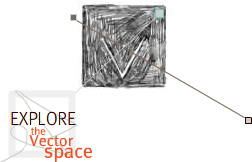Hypermedia Berlin
Cultural History in the Age of New Media, or "Is There a Text in this Class?"
Author's Statement
http://www.berlin.ucla.edu/hypermedia (Use this link to open Hypermedia Berlin before launching the Flash 'walkthrough' to the right.)
"Hypermedia Berlin" is a collaborative, multimedia, web-based research and curriculum development project, which investigates, analyzes, and maps the architectural, cultural, and historical layers of Berlin's city space. The project can be understood as a multimedia descendent of Walter Benjamin's famous attempt to map the Paris of the nineteenth century in the Arcades Project. Explicitly disavowing any kind of linear, chronological, or teleological model of historiography, "Hypermedia Berlin," like the Arcades Project, is organized topographically in order to examine the complex relationship between cultural production, mobility, and space. While Benjamin attempted to create a "montage" text to study Paris, I am proposing that the technologies of the Web and new media offer the possibility of conceptualizing a radically new approach to cultural history, something that Benjamin was not able to fully realize in the Arcades Project. I have to believe that Benjamin would have found the tools of new media, specifically the rhizomatic techniques of hypertext and the hypermedia possibilities of the World Wide Web, especially well suited to "giving dates their physiognomy" and realizing what he once called "the Copernican revolution in historical perception."
"Hypermedia Berlin" is organized according to "Zeitschichten," or time-layers, in which the uneven spatial and temporal coordinates of Berlin's cultural and architectural histories can be apprehended. Unlike traditional models of history, which proceed chronologically and take the linearity of temporality as their structuring principle, "Hypermedia Berlin" attempts to articulate Berlin's time-layers through a multiplicity of maps connected together by interlinking "hotspots" at key regions, structures, and streets. These maps function as historical palimpsests of the city, thereby spatializing historical practice and transforming cultural history into a kind of "cultural geography."
With the technical support of UCLA's Center for Digital Humanities as well as the financial support of UCLA's Academic Senate Faculty Grants Program, UCLA's Office of Instructional Development, and the Stanford Humanities Laboratory, the pilot version of "Hypermedia Berlin" was launched in the spring of 2004. I initially conceived of the project as a "Hypermedia-Hypertextbook" of Berlin for use in the classroom. To this end, we began developing an extensive digital archive of interconnected maps and photographs of Berlin. As the project rapidly grew, it quickly became apparent that we would need to develop a content management system to edit, search, and present the vast amount of material. Moreover, we needed a way for students, researchers, and the general public to interact with and contribute to the site. We are currently developing the first content management system for "Hypermedia Berlin." In addition to about fifty interconnected and fully annotated maps of Berlin over its nearly 800-year history, the site will include a digital library interface with a searchable database of photographs, an e-scholarship interface with peer-reviewed essays in hypertext format, an extensive blogger function for general authorship, and a customizable "My-Hypermedia Berlin" that will allow teachers and students interested in any aspect of Berlin to excerpt and create their own course or research material. We hope to launch the content management system within a year, something that will distinguish "Hypermedia Berlin" as a unique research and curriculum development portal on the city.
For my Vectors' contribution, I created a Flash film of the first phase of the project in which I discuss both the pedagogical and research challenges that this media presents for historical methodology, disciplinary practice, and classroom pedagogy. The film runs about 15 minutes and can be paused, fast-forwarded, or rewound. To view the film, just launch the project. To view the pilot version of "Hypermedia Berlin," please visit http://www.berlin.ucla.edu/hypermedia.



